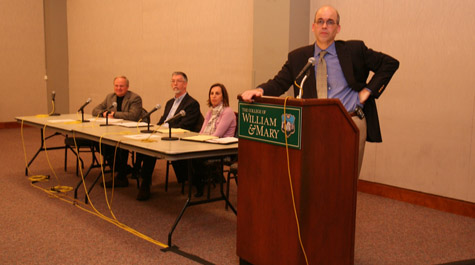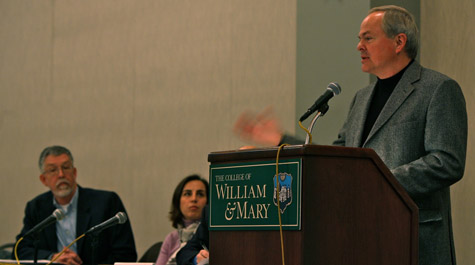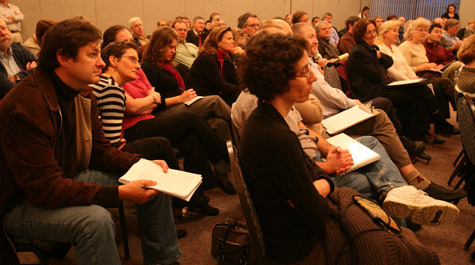Teaching and research: All about the sauce
A group of more than 100 faculty, staff and students pondered the recipe of the College's "special sauce"-a combination of ingredients that, properly blended, allow for the smooth incorporation of research activity into the education of many William & Mary students.
The concept of "special sauce" was introduced by Mark Patterson, one of three faculty panelists at the second installment of the ongoing Campus Conversation series, addressing various aspects of William & Mary as a leading liberal arts university in the 21st Century. The sessions, convened, hosted and moderated by Provost Michael R. Halleran, are part of the strategic planning process under way at the College.
Wednesday's session was titled "Does Research Bring Us Together? The Blend of Teaching and Research in W&M in the 21st Century." In addition to the special sauce recipe, discussion revolved around topics ranging from differences and commonalities among disciplines, the roles of undergraduates and undergraduates in research and the various ways that research, scholarship and creative endeavors enhance the learning experience. In his introduction, Halleran urged the faculty to "use the term 'research' in the broadest possible sense."
Patterson, from the Biological Sciences Department at the Virginia Institute of Marine Science, was joined on the panel by Vassiliki (Lily) Panoussi from Classical Studies and Eric Jensen from Economics and Public Policy. As the panelists represented the natural sciences, the humanities and the social sciences, each was able to give a different view of how research can fit into the framework of the educational mission of various disciplines. The panelists' brief presentations were followed by discussion among the faculty.
"Research means different things for different disciplines," Panoussi said, noting that she is married to a physicist. "They (physicists) need graduate students; we don't. Classicists work alone. We need a single-author book to get tenure."
Acknowledging the differences among academic cultures and demands of various disciplines is important, she said. "We need to define ‘research university' in broad terms and embrace those differences and not have a narrow definition."
Panoussi said she found the term "undergraduate research" to be misleading and preferred the phrase "research-based teaching" put forth in the pre-discussion position statement of fellow panelist Eric Jensen. She said it's important for faculty to help to form students' research experience.
"If they're taught by someone who is active in research, they will see the process of how new knowledge is obtained. You can do a lot of research-based teaching in the classroom," Panoussi said. She suggested one avenue might involve small, research-intensive tutorial classes. "Students feed off our own enthusiasms. We're lucky to have excellent students here. In Classics, we're spoiled; you don't get slackers in Greek and Latin."
Jensen, the second panelist to speak, said he is interested in the balance of research and teaching. He said he had a number of conversations with physicist Gene Tracy, in which, "because we're both kind of math geeks," they use the term "unstable equilibrium" to describe how many faculty combine their teaching duties with research activity.
"We're balanced on this pointy fulcrum," he explained, "and there's a tendency to fall off toward the research or the teaching at any moment and we have to maintain our balance." Jensen said that he lately has come to prefer the term "blend," as proposed by Vice President for Strategic Initiatives Jim Golden, to describe the integration of research with teaching.
"Balance requires opposition," he explained. "In order to keep from falling off on one side, we need to put more weight on the other. That's not always helpful in terms of the discussion we want to have, because it tends to put us in opposing camps. So I think it's blend instead of balance."
Jensen said he likes the particular blend of research and teaching that exists at William & Mary, an institution that exists as an alternative to the nation's "big research mills" on one hand and the liberal arts colleges on the other.
"So why are we doing research?" he asked. "Well, I do it because I like it. We do it because we like it. It's a quality of life issue. We can't recruit or retain the colleagues that we want without this real commitment to research."
Speaking as an economist, he said that the real question is: "How are we going to differentiate ourselves from those mills and from those liberal arts colleges?" Jensen suggested "research-based teaching" as a model and the goal to be to create "experiences that will essentially put them out the door having already experienced some of what they're going to be doing.
"That means we need to know how to do it," he said. "We have to have an active research agenda and we have to pass it along. It also means that are certain budgetary implications of a faculty-intensive model. We have to be able to spend time with our students and so the real commitment to this may be best deferred to sunnier financial time."
Patterson, the last panelist, told of being among a group of biology undergrads required to take a physics class. "The department chairman tossed us the keys to the wind tunnel and said, ‘Let me know when you have found out something about lift and drag. And don't break the wind tunnel'," he said.
Over the next few weeks, the young biologists put a number of objects-beginning with each other and ending with a balsa model of a Volkswagen-into the wind tunnel. Patterson said a number of revelations came out of the tunnel, including an understanding that the same fluid forces they observed also act on marine organisms, many of which have evolved to deal with them. Patterson went on to apply the evolved mechanisms of marine life to the design and construction of autonomous underwater vehicles.
Patterson cited a report that-contrary to the perceived William & Mary experience-indicated that some studies have found no correlation (or even a negative correlation) between the quality of an institution's teaching and the quality of its research. The secret of successes realized at William & Mary, he said, might lie in a quality he called "special sauce."
The sauce had immediate resonance; most participants in the open discussion mentioned it. "What is our special sauce?," Halleran asked after Patterson finished his presentation. "Or maybe I should phrase that a little differently: Do we need to change the ingredients of our special sauce?"
Patterson responded that the problem with special sauce is that the recipe remains a mystery. "I can guess at some of the components. One thing that I found that was very important for me was the ability to go into a professor's office and occupy their time and feel like I had their undivided attention when I was an undergraduate and then go back and continue that relationship that took off after the initial meeting.," he said. "That's something I see here, enviously-because we don't have undergraduates out at VIMS. When I visit the main campus to teach here, I see that most of you have a wonderful open-door policy."
Jensen said that he believed the sauce required slow cooking. "It takes time to simmer that sauce and that means that we have to recognize that, at some level, you'll need time to spend teaching students, talking to students, doing your own research. There are going to have to be some discrete blocks of time to capture the synergies that are there."
Christopher Del Negro of Applied Science began the discussion from the floor by suggesting that an important ingredient in the sauce is a culture and a structure that foster interdepartmental collaboration.
"I was a post-doctoral fellow at UCLA and at the National Institutes of Health, and at both of those facilities I only interacted with other neuroscientists who know exactly what I know and who do exactly what I do," Del Negro said. "My papers were straightforward neuroscience papers, but since I've been at William & Mary I've already published papers with people in different departments, with undergraduate students and I've interacted with more physicists, mathematicians and molecular biologists than in the previous eight years. So I think that our special sauce is small academic units and talking with one another."
David Kranbuehl of Chemistry contributed a couple of ingredients to the saucepot-class size and people. "If you teach a class of 100 and you have an open-door policy, just by definition, you're going to be swamped. So we have to be very, very careful about size," he said. "In terms of the sauce, I think the key is attracting the right people, to attract people whose first interest is teaching. In addition, we want people who care deeply, and who have a passion for research."
Kranbuehl also acknowledged Panoussi's remarks about differences in research across disciplines.
"Lily, the way you described it: you are teaching research, by the very fact of everything you've told us about your courses," he said. "It's totally different from those of us in the sciences whose students go into the labs and they get a hands-on experience in what I call research-learning how to answer unanswered questions. The textbook deals with answered questions. We're teaching them how to deal with unanswered questions."
Even though not all the academic departments in Arts & Sciences have graduate programs, grad students should be part of the teaching-research blend, according to Tim Barnard. A faculty member in English, American Studies and Film Studies, Barnard noted that he also is an alumnus of the American Studies graduate program.
"I always strongly recommend to American Studies and English majors the 470s, the advanced seminars that graduate students teach. These graduate students are at the forefront of their research," Barnard said. "They're experts on their topics. They teach on topics related to their dissertations. They have passion for that subject, they're dedicated to teaching-they're new teachers, so they want to learn. I think that undergraduates, then, get a unique learning experience-and one that is intensively tied to research.
"It's part of the conflict in being a liberal arts university," Barnard continued. "If you're going to call yourself a university, the fact is: you have grad students. There are ways in which grad students can, and should be, part of the special sauce."
"One of the frustrations that I hear often is the question of access," said Silvia Tandeciarz of Modern Languages and Literatures, who added that she is also working in the office of Arts & Sciences Dean Carl Strikwerda. "Many faculty have found very creative ways of involving students in the field when the field isn't here on campus at William & Mary. That takes money. It takes money to get faculty there and to get students there. Some students can afford to pay for that kind of experience, but not all students can."
She said that some faculty have access to professional development funds, but suggested continued thought about how to make field experiences sustainable in the long run.
Halleran asked for thoughts about the possible formal incorporation of a senior research experience into undergraduate curricula. The response suggested that, no matter how special, one sauce would not suit all.
Bill Cooke of Physics said that his department had a formal research experience dating back decades, with all seniors doing a research-based honors project. On the other hand, Kate Slevin countered by noting that students often enter college with vague, often incorrect understandings of what sociology is.
"Consequently, in Sociology, our majors often declare in their junior year," she said. "There is no time to build up to an undergraduate research experience."


















